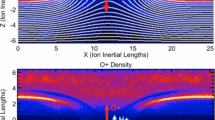Abstract
The ion and electron plasma experiment on the Fast Auroral Snapshot satellite (FAST) is designed to measure pitch-angle distributions of suprathermal auroral electrons and ions with high sensitivity, wide dynamic range, good energy and angular resolution, and exceptional time resolution. These measurements support the primary scientific goal of the FAST mission to understand the physical processes responsible for auroral particle acceleration and heating, and associated wave-particle interactions. The instrument includes a complement of 8 pairs of `Top Hat' electrostatic analyzer heads with microchannel plate (MCP) electron multipliers and discrete anodes to provide angle resolved measurements. The analyzers are packaged in four instrument stacks, each containing four analyzers. These four stacks are equally spaced around the spacecraft spin plane. Analyzers mounted on opposite sides of the spacecraft operate in pairs such that their individual 180° fields of view combine to give an unobstructed 360° field of view in the spin plane. The earth's magnetic field is within a few degrees of the spin plane during most auroral crossings, so the time resolution for pitch-angle distribution measurements is independent of the spacecraft spin period. Two analyzer pairs serve as electron and ion spectrometers that obtain distributions of 48 energies at 32 angles every 78 ms. Their standard energy ranges are 4 eV to 32 keV for electrons and 3 eV to 24 keV for ions. These sensors also have deflection plates that can track the magnetic field direction within 10° of the spin plane to resolve narrow, magnetic field-aligned beams of electrons and ions. The remaining six analyzer pairs collectively function as an electron spectrograph, resolving distributions with 16 contiguous pitch-angle bins and a selectable trade-off of energy and time resolution. Two examples of possible operating modes are a maximum time resolution mode with 16 angles and 6 energies every 1.63 ms, or a maximum energy resolution mode with 16 angles and 48 energies every 13 ms. The instrument electronics include mcp pulse amplifiers and counters, high voltage supplies, command/data interface circuits, and diagnostic test circuits. All data formatting, commanding, timing and operational control of the plasma analyzer instrument are managed by a central instrument data processing unit (IDPU), which controls all of the FAST science instruments. The IDPU creates slower data modes by averaging the high rate measurements collected on the spacecraft. A flexible combination of burst mode data and slower `survey' data are defined by IDPU software tables that can be revised by command uploads. Initial flight results demonstrate successful achievement of all measurement objectives.
Similar content being viewed by others
References
Boehm, M., Paschmann, G., Clemmons, J., Hoefner, H., Frenzen, R., Ertl, M., Haerendel, G., Hill, P., Lauche, H., Eliasson, L. and Lundin, R.: 1994, ‘The TESP Electron Spectrometer and Correlator (F7) on Freja', Space Sci. Rev. 70, 509.
Carlson, C. W., Curtis, D. W., Paschmann, G., and Michael, W.: 1983, in D. McDiarmid (ed.), ‘An Instrument for Rapidly Measuring Plasma Distribution Functions with High Resolution', Adv. Space Res. 2, 67.
Carlson, C.W., Pfaff, R.W., and Watzin, J. G.: 1998a, ‘The Fast Auroral Snapshot (FAST) mission', Geophys. Res. Lett., 25, 2013.
Carlson, C. W. and McFadden, J. P.: 1998, in R. F. Pfaff, J. E. Borovsky, and D. T. Young (eds.), ‘Design and Application of Imaging Plasma Instruments', Measurement Techniques in Space Plasmas: Particles, Geophys. Monogr. 102, AGU, Washington, p. 125.
Ergun, R. E., Carlson, C. W., Mozer, F. S., Delory, G. T., Temerin, M., McFadden, J. M., Pankow, D., Abiad, R., Harvey, P., Wilkes, R., Primbsch, H., Elphic, R., Strangeway, R., Pfaff, R., and Cattell, C. A.: 2000, ‘The FAST Satellite Electric Field and Magnetic Field Instruments', Space Sci. Rev., this issue.
Gurnett, D. A.: 1974, ‘The Earth as a Radio Source: Terrestrial Kilometric Radiation', J. Geophys. Res. 79, 4227.
Harvey, P. R., Curtis, D. W., Heetderks, H. D., Pankow, D., Rauch-Leiba, J. M., Wittenbrock, S. K., and McFadden, J. P.: 2001, ‘The FAST Spacecraft Instrument Data Processing Unit', Space Sci. Rev., this issue.
Klumpar, D. M.: 1986, in T. Chang (ed.), ‘A Digest and Comprehensive Bibliography on Transverse Auroral Ion Acceleration', Ion Acceleration in the Magnetosphere and Ionosphere, Geophys. Monogr. 38, AGU, Washington, p. 389.
McFadden, J. P., Carlson, C. W., and Boehm, M. H.: 1986, ‘Field-aligned Electron Precipitation at the Edge of an Arc', J. Geophys. Res. 91, 1723.
McFadden, J. P., Carlson, C. W., Boehm, J. H., and Hallinan, T. J.: 1987, ‘Field-aligned Electron Flux Oscillations that Produce Flickering Aurora', J. Geophys. Res. 92, 11133.
McFadden, J. P. and Carlson, C. W.: 1998, in R. F. Pfaff, J. E. Borovsky, and D. T. Young (eds.), ‘Computer Simulation in Designing Electrostatic Optics for Space Plasma Experiments', Measurement Techniques in Space Plasmas: Particles, Geophys. Monogr. 102, AGU, Washington, p. 249.
McFadden, J. P., Carlson, C. W., Ergun, R. E., Chaston, C. C., Mozer, F. S., Temerin, M., Klumpar, D. M., Shelley, E. G., Peterson, W. K., Moebius, E., Kistler, L., Elphic, R., Strangeway, R., Cattell, C., and Pfaff, R.: 1998b, ‘Electron modulation and ion cyclotron waves observed by FAST', Geophys. Res. Lett. 25, 2045.
McFadden, J. P., Carlson, C. W., and Ergun, R. E.: 1999, ‘Microstructure of the auroral acceleration region as observed by FAST', J. Geophys. Res. 104, 14453.
McFadden, J. P., Ergun, R. E., Carlson, C. W., Herrick, W., Loran, J., Vernetti, J., Teitler, W., Bromund, K., and Quinn, T.: 2001, ‘Science Operations and Data Handling for the FAST Satellite', Space Sci. Rev., this issue.
Mozer F. S., Carlson, C.W., Hudson, M. K., Torbert, R. B., Parady, B. Yatteau, J., and Kelley, M. C.: 1977, ‘Observation s of paired Electrostatic Shocks in the Polar Magnetosphere', Phys. Rev. Lett. 38, 292.
Pankow, D., Besuner, R., Ullrich, R., and Wilkes, R.: 2001, ‘Deployment Mechanisms on the FAST Satellite: Radial Wires, Stiff Axials, and Magnetometer Booms', Space Sci. Rev., this issue.
Pfaff, R., Carlson, C. W., Watzin, J., Everett, D., and Gruner, T.: 2001, ‘An overview of the FAST Auroral Snapshot (FAST) Mission', Space Sci. Rev., this issue.
Sharp, R. D., Shelley, E. G., Johnson, R. G., and Ghielmetti, A. G.: 1980, ‘Counterstreaming Electron Beams at Altitudes of ∼1 RE over the Auroral Zone', J. Geophys. Res. 85, 92.
Strangeway, R. J., Kepko, L., Elphic, R. C., Carlson, C. W., Ergun, R. E., McFadden, J. P., Peria, W. J., Delory, G. T., Chaston, C. C., Temerin, M., Cattell, C. A., Moebius, E., Kistler, L. M., Klumpar, D. M., Peterson, W. K., Shelley, E. G., and Pfaff, R. F.: 1998, ‘FAST observations of VLF waves in the auroral zone: Evidence of very low plasma densities', Geophys. Res. Lett. 25, 2065.
Temerin, M. A., Carlson, C.W., Cattell, C. A., Ergun, R. E., McFadden, J. P., Mozer, F. S., Klumpar, D. M., Peterson, W. K., Shelley, E. G., and Elphic, R. C.: 1990, in T. Chang (ed.), ‘Waveparticle Interactions on the FAST Satellite’, Physics of Space Plasmas, Scientific Publishers, Inc., Cambridge, MA., p. 343.
Author information
Authors and Affiliations
Rights and permissions
About this article
Cite this article
Carlson, C., McFadden, J., Turin, P. et al. The Electron and ion Plasma Experiment for Fast. Space Science Reviews 98, 33–66 (2001). https://doi.org/10.1023/A:1013139910140
Issue Date:
DOI: https://doi.org/10.1023/A:1013139910140




